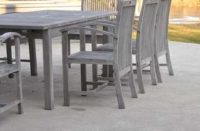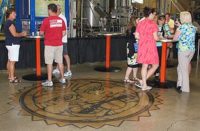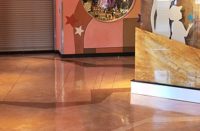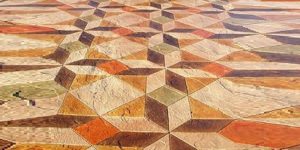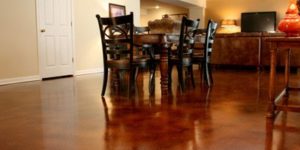Much like the right mix for Grandma’s homemade apple pie or Mom’s hearty chicken noodle soup, a recipe for a beautiful concrete stain requires just the right ingredients, in just the right amounts and in careful applications.
We asked contractors and manufacturers to share a few of their favorite concrete concoctions.
Here’s what they said:

1. Sandstone/Weathered Sage Color-Texture Combination
Tom Ralston Concrete — Santa Cruz, Calif.
Ingredients:
Concrete: Six-sack 3,000-psi mix design (in California use Type II cement)
1,650 pounds 3/4-inch angular rock
3-inch to 4-inch slump of water (39 gallons/yard)
1 bag of stealth fiber mesh (1 pound)
Allow 2 percent to 4 percent air entrainment in the mix to improve workability and flowability, or allow up to 5 percent in areas prone to freeze-thaw.
Matte stamps (Italian Slate pattern)
Alcantar Oyster Shell color hardener
Alcantar Sandstone color hardener
Alcantar Weathered Sage release agent
Directions:
Pour concrete. After bleed water has left the surface, broadcast Sandstone color hardener over entire surface. Wood-float for “mechanical bonding” of color hardener and poured concrete.
While concrete is making its first set, deep-score border bands of any width, generally 12 inches wide.
Apply Oyster Shell color hardener to all concrete, including border bands. Swirl-trowel or hard-trowel the bands.
As surface hardens, apply Weathered Sage release agent to the interior panels (within the bands), then apply matte stamps. A shallow, light slate or Italian slate texture is popular with customers. Sometimes we will combine matte stamps for a unique, one-of-a-kind texture. Let stand overnight.
Use a power washer to remove release agent from the surface of the panels.
If you want to acid-wash to create a worn, weathered look, use a solution of 1 part acid, 8 parts water, carefully masking off any panels not to be acid-washed. Let stand overnight.
For exterior surfaces, seal with recommended lacquer sealer to enhance color combination.

2. Oyster White/Sandstone Color-Texture Combination
Tom Ralston Concrete — Santa Cruz, Calif.
Ingredients:
Concrete: Six-sack 3,000-psi mix design (in California use Type II cement)
1,650 pounds 3/4-inch angular rock
3-inch to 4-inch slump of water (39 gallons/yard)
1 bag of stealth fiber mesh (1 pound)
Allow 2 percent to 4 percent air entrainment in the mix to improve workability and flowability, or allow up to 5 percent in areas prone to freeze-thaw.
Matte stamps (Italian Slate and Caesar Texture Matte patterns, or any combination that will give a unique, varied texture)
Alcantar Oyster Shell color hardener
Alcantar Sandstone release agent
Directions:
Pour concrete. After bleed water has left the surface, broadcast Oyster Shell color hardener over entire surface. Wood-float for “mechanical bonding” of color hardener and poured concrete.
Deep-score bands while concrete is taking its first set. Swirl-trowel or hard-trowel the bands.
As surface hardens, apply Sandstone release agent to the interior panels (within the bands), then apply matte stamps. Let stand overnight.
Use a power washer to remove release agent.
Acid-wash bands, if desired, with a solution of 1 part acid, 8 parts water, carefully masking off panels not to be acid-washed.
For exterior surfaces, seal with recommended lacquer sealer to enhance color combination.

3. Texas Tuscan
L.M. Scofield — Los Angeles, Calif.
Ingredients:
1 Pennsylvania Slate Pavecrafters tool set
(30 single-stone Prestige tools varying in size from
6 inches by 6 inches to 3 feet by 4 feet)
Arizona Tan Lithochrome color hardener
Russet color hardener
Terra cotta color hardener
La Crescenta Brown release agent
Directions:
Pavecrafters tool set allows for random pattern layout in variations that do not appear to repeat, and the result looks like custom hewn-stone work. After base is imprinted, use Lithochrome color hardener to provide a rich paste that gives decorative concrete patterns a crisp edge. Broadcast high-opacity Arizona Tan and work into upper layer of concrete to improve density and durability for vehicular traffic. Randomly distribute Russet and Terra Cotta color hardener over surface, then float and trowel into concrete. Use colored powdered release agent in La Crescenta Brown to clean and release concrete stamping tools and add depth to pattern.
This project is an award winner in the 2006 Concrete Pavement Awards for “decorative and durable designs” using cast-in-place concrete.

4. Six-Inch Random Wood Plank
Proline Concrete Tools — Oceanside, Calif.
Ingredients:
Proline Navajo color hardener
Liquid release stamping agent
6-inch random wood plank stamp
Proline Dura-Stain Oak acid stain
Proline Dura-Stain Black acid stain
Proline EZ-Accent Pinto and Sandstone water-based acrylic stains
Proline EZ-Tique Santa Fe and El Paso water-based antique color washes
Proline Dura-Seal
Directions:
Stain border with Dura-Stain Oak acid stain. Highlight with a touch of Black Dura Acid stain to darken in places. Accent individual planks with EZ-Accent acrylic stains — the Pinto and Sandstone colors are recommended. Leave the rest the unstained Navajo color. Allow stains to dry. Apply antiquing with EZ-Tique antique color washes; use Santa Fe and El Paso colors to tone down stains, highlight textures and joints, and bring all colors together. Seal with two coats of Dura-Seal to bring out all colors.

5. Rotating Ashlar Roman Slate
Proline Concrete Tools — Oceanside, Calif.
Ingredients:
Proline Oceanside color hardener
Liquid release stamping agent
Proline Ashlar Roman Slate texture mats
Proline Dura-Stain Redwood acid stain
Proline EZ-Accent Pinto, Sandstone and Mission Brown water-based acrylic stains
Proline EZ-Tique Black water-based antique color wash
Proline Dura-Seal
Directions:
Stain border with Dura-Stain Redwood acid stain. Accent individual stones with Proline EZ-Accent acrylic translucent stains (Pinto, Sandstone and Mission Brown). Leave the rest the unstained Oceanside color. Allow stains to dry. Apply antiquing with EZ-Tique Black color wash to tone down stains, highlight textures and joints, and bring all colors together. Seal with two coats of Dura-Seal to bring out all the colors.

6. Proline 4-Foot Compass
Proline Concrete Tools — Oceanside, Calif.
Ingredients:
Proline Adobe Beige color hardener
Liquid release
Proline 4-foot compass stamp
Proline EZ-Accent Sandalwood, Buckskin, Spanish Buff, Fairway Green, Slate Blue and Mission Brown water-based acrylic stains
Proline EZ-Tique Mocha and El Paso water-based antique color washes
Proline Dura-Seal
Directions:
Stain wood grain border with EZ-Accent acrylic translucent, using Sandalwood, Buckskin and a touch of Spanish Buff. Accent individual pieces of the compass with EZ-Accent in Fairway Green, Slate Blue, Mission Brown, Spanish Buff and Sandalwood. Leave name plaque unstained, colored only by Adobe Beige. Allow stains to dry. Apply EZ-Tique color wash in Mocha and El Paso colors to tone down stains, highlight textures and joints and bring colors together. Apply two coats of Dura-Seal to bring out all colors.

7. General Coloring Instructions
Specialty Concrete Products — West Columbia, S.C.
Instructions:
Consider pattern (if stamped concrete or stamp overlayment).
Use color schemes that replicate natural materials. For a cobblestone pattern, use a light-to-dark gray scheme. Use sable as the main color, marbleize in Philly blue and sun gray, and use charcoal release agent. For a random stone pattern, try a light-brown-to-dark-brown scheme. Use adobe buff as the main color; marbleize in autumn brown and desert tan, and use walnut release agent.
Choose colors that complement and do not clash with building colors. Do not try to match construction color; it is difficult to do and often too overwhelming if successful.
Take the same factors into consideration when using multiple release agents and stone shading.
Starting with a light main color and using darker release agent and stone-shade colors yields a nice effect.
When acid staining with color hardeners, use white or antique white for main color; marbleize in light grays (pewter, sable) or light buffs (adobe buff and sun buff).
8. Marbleizing with Multiple Color Hardeners
Specialty Concrete Products — West Columbia, S.C.
Instructions:
Choose one prominent color shade. Other shades of color hardener within the same family will provide highlighting/marbleizing effect.
Per manufacturer’s instructions, work in primary color hardener. Finish final pass to desired surface profile.
Randomly broadcast all but one of the remaining colors across the surface, taking care not to create a repetitive pattern. Work colors into surface from different angles. The less the colors are worked in, the starker the difference between the main color and the highlights; the more they are worked in, the more subtle the highlights.
Apply the final color over the entire job, creating a uniform antiquing color, especially within grout lines.
This technique can be used with the main color being an integral color.

9. Multiple Release Agents
Specialty Concrete Products — West Columbia, S.C.
Instructions:
When using several colors of release agent with a single color hardener or integral color, for best results, apply release agent colors over a lighter main color. Work in main color with color hardener or integral color. Take finish to desired surface profile. Broadcast several release agent colors across the surface, alternating handfuls prior to stamping.
10. Color Hardener & Acid Staining
Specialty Concrete Products — West Columbia, S.C.
Instructions:
The following technique allows for use of a spectrum of light color hardeners to create a lighter marbleized surface to acid stain. A brighter, more vivid acid stain with more color variation will result. This can be used over stamped surfaces or smooth finish surfaces.
— Work in multiple colors of color hardener. The very light color spectrum is best.
— Allow concrete to cure per manufacturer’s recommendation.
— Acid-stain concrete

11. Stone Shades
Specialty Concrete Products — West Columbia, S.C.
Instructions:
This technique uses translucently pigmented seal coats (SCP Stone Shades) to provide a custom shade over decorative work. Use to shade individual portions of a job or the entire job.
— Apply one coat of seal to wet out colors. This helps keep the Stone Shade in a liquid state so pigmentation can flow in the film and create desired highlights over textured surfaces.
— Apply final coat of clear seal.
— Allow final coat to penetrate into first coat so pigmentation rises to close to concrete surface.
